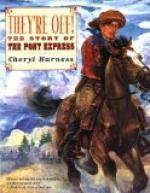William James, always called “Bill” James, was a native of Virginia. He had crossed the plains with his parents in a wagon train when only five years old. At eighteen, he was one of the best Pony Express riders in the service. James’s route lay between Simpson’s Park and Cole Springs, Nevada, in the Smoky Valley range of mountains. He rode only sixty miles each way but covered his round trip of one hundred and twenty miles in twelve hours, including all stops. He always rode California mustangs, using five of these animals each way. His route crossed the summits of two mountain ridges, lay through the Shoshone Indian country, and was one of the loneliest and most dangerous divisions on the line. Yet “Bill” never took time to think about danger, nor did he ever have any serious trouble.
Theodore Rand rode the Pony Express during the entire period of its organization. His run was from Box Elder to Julesburg, one hundred and ten miles and he made the entire distance both ways by night. His schedule, night run though it was, required a gait of ten miles an hour, but Rand often made it at an average of twelve, thus saving time on the through schedule for some unfortunate rider who might have trouble and delay. Originally, Rand used only four or five horses each way, but this number, in keeping with the revised policy of the Company, was afterward doubled, an extra mount being furnished him every twelve or fifteen miles.
Johnnie Frey who has already been mentioned as the first rider out of St. Joseph, was little more than a boy when he entered the pony service. He was a native Missourian, weighing less than one hundred and twenty-five pounds. Though small in stature, he was every inch a man. Frey’s division ran from St. Joseph to Seneca, Kansas, eighty miles, which he covered at an average of twelve and one half miles an hour, including all stops. When the war started, Frey enlisted in the Union army under General Blunt. His short but worthy career was cut short in 1863 when he fell in a hand-to-hand fight with rebel bushwhackers in Arkansas. In this, his last fight, Frey is said to have killed five of his assailants before being struck down.
Jim Beatley, whose real name was Foote, was another Virginian, about twenty-five years of age. He rode on an eastern division, usually west out of Seneca. On one occasion, he traveled from Seneca to Big Sandy, fifty miles and back, doubling his route twice in one week. Beatley was killed by a stage hand in a personal quarrel, the affair taking place on a ranch in Southern Nebraska in 1862.
William Boulton was one of the older riders in the service; his age at that time is given at about thirty-five. Boulton rode for about three months with Beatley[24]. On one occasion, while running between Seneca and Guittards’, Boulton’s horse gave out when five miles from the latter station. Without a moment’s delay, he removed his letter pouch and hurried the mail in on foot, where a fresh horse was at once provided and the schedule resumed.




